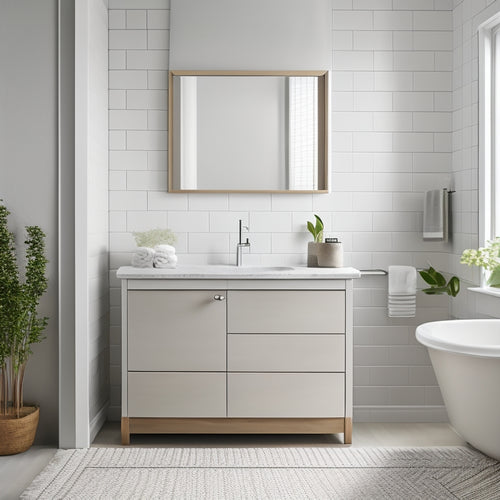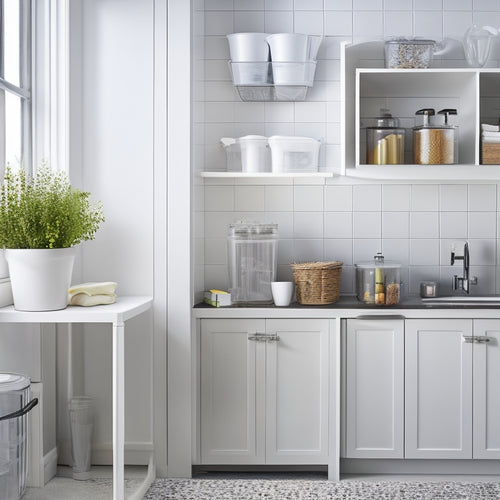
Boost Home Value With Closet Organizers
Share
Effective closet organizers greatly boost home value by transforming cluttered spaces into functional and aesthetically pleasing areas that appeal to potential buyers. A well-designed closet organization system can increase storage capabilities, enhance functionality, and create a sense of calm. Customization options cater to unique needs, addressing space constraints and elevating the aesthetic appeal. By incorporating shelves, drawers, and rods, homeowners can maximize space and create a visually stunning area. As you explore the world of closet organizers, discover how a thoughtful investment can yield a substantial return, and uncover the secrets to creating a tranquil and valuable living space.
Key Takeaways
• Customized closet organizers increase home value by creating functional and aesthetically pleasing spaces that appeal to potential buyers.
• Well-designed closet systems maximize storage capabilities, enhancing functionality and overall livability of the home.
• High-quality materials and thoughtful design elevate the aesthetic appeal of the closet, making it a valuable selling point.
• A clutter-free and organized closet reduces stress and increases a sense of tranquility, making the home more desirable to buyers.
• Investing in a closet organizer system yields substantial returns, with some renovations recouping up to 100% of their cost at resale.
Assessing Closet Clutter Impact
Evaluating the contents of your closet is an essential step in maximizing its potential, as cluttered spaces can not only stifle functionality but also contribute to elevated stress levels and a disorganized lifestyle.
To declutter stress, it's important to analyze the amount of items in your closet and determine if they are frequently used. By doing so, you can identify non-essential items that can be removed, making room for a more organized and peaceful space.
Evaluating usage also helps you understand how you interact with your closet, revealing opportunities to optimize storage and create a more functional layout.
Maximizing Closet Organizer ROI
As you begin the journey to optimize your closet's functionality, understanding the potential return on investment (ROI) of closet organizers becomes an essential consideration, particularly in a competitive real estate market where every advantage counts.
To maximize ROI, focus on customization benefits that cater to your unique needs and space constraints. This tailored approach will not only enhance the functionality of your closet but also increase its appeal to potential buyers.
Prioritize maintenance to guarantee the system remains in pristine condition, maintaining its value over time.
Invest in high-quality materials that exude style and sophistication, elevating the overall aesthetic of your closet.
Highlight the customization as a unique selling point, setting your property apart from others in the market.
Optimizing Closet Organization Systems
A well-designed closet organization system can be a game-changer for homeowners seeking to enhance their storage capabilities. A thoughtful integration of shelves, drawers, and rods is capable of transforming even the most cramped spaces into havens of tranquility and efficiency.
By incorporating closet organization tips, such as double rods and shelves, homeowners can maximize their space and create a more organized and peaceful environment. Design trends, such as closet customization, can also play a significant role in optimizing closet organization systems.
Frequently Asked Questions
Can I Install Closet Organizers Myself or Do I Need a Professional?
When considering DIY closet organizers, assess your DIY confidence against the complexity of the project, weighing the potential savings against Professional fees and the risk of a subpar installation that may negatively impact resale value.
How Do I Decide What Type of Closet Organizer System Is Best for Me?
When selecting a closet organizer system, consider your Personal Style, Lifestyle Needs, and daily habits to determine the ideal configuration. Assess your fashion preferences, storage requirements, and desired level of organization to create a tailored solution that resonates with your unique aesthetic and functional needs.
Will Closet Organizers Fit in My Small or Irregularly Shaped Closet?
Small or irregularly shaped closets present unique challenges, but custom solutions can expertly optimize space, ensuring a seamless fit. By leveraging innovative design and precise measurements, expert installers can craft a tailored system that maximizes storage and style.
Can I Reuse or Repurpose Existing Closet Storage Components?
"Reinvigorate your closet with upcycled materials and creative refurbishing, breathing new life into existing storage components. Repurpose shelves, rods, and drawers to create a bespoke organization system that exudes style and sophistication."
Are Closet Organizers Only Beneficial for Homeowners, Not Renters?
While often associated with homeowners, closet organizers also benefit renters by providing a sense of control and calm, with Renter Benefits including increased storage and organization, and Leasing Incentives such as extended tenancy and referrals.
Conclusion
The incorporation of closet organizers yields a substantial return on investment, with a reported 57% average ROI. This significant value boost can be attributed to the enhanced functionality, aesthetics, and organization that customized closet systems provide.
By optimizing closet space, homeowners can differentiate their property in competitive markets, increase storage capacity, and reduce stress levels. The data-driven benefits of closet organizers make a compelling case for their integration into home design, ultimately contributing to a more attractive and valuable living space.
Related Posts
-

Why Bathroom Storage Matters for a Clutter-Free Home
You recognize that a clutter-free bathroom is essential to your daily routine, but did you know that clever bathroom ...
-

Corner Solutions for Kitchen Cleaning Supplies
You can investigate corner solutions that improve access to cleaning supplies. This can be practiced by maximizing hi...

